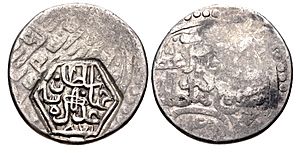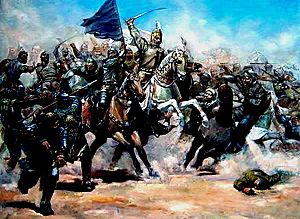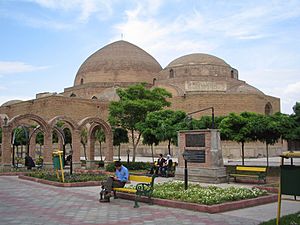Qara Qoyunlu facts for kids
Quick facts for kids
Qara Qoyunlu
قره قویونلو
|
|||||||||||
|---|---|---|---|---|---|---|---|---|---|---|---|
| 1374–1468 | |||||||||||

Qara Qoyunlu Turkomans, lighter blue shows their greatest extent in Iraq and Arabian East Coast for a small period of time
|
|||||||||||
| Status | Confederation | ||||||||||
| Capital | |||||||||||
| Common languages |
|
||||||||||
| Religion | Shia Islam (possibly) | ||||||||||
| Government | Monarchy | ||||||||||
| Ruler | |||||||||||
|
• 1375–1378
|
Bayram Khwaja (first) | ||||||||||
|
• 1467–1468
|
Hasan Ali (last) | ||||||||||
| Historical era | Middle Ages | ||||||||||
|
• Established
|
1374 | ||||||||||
|
• Disestablished
|
1468 | ||||||||||
| Currency | Akçe Tanka |
||||||||||
|
|||||||||||
The Qara Qoyunlu, also known as the Black Sheep Turkomans, was a powerful group of Turkoman tribes. They formed a kingdom that ruled parts of the Middle East from about 1374 to 1468. This area included modern-day Azerbaijan, Georgia, Armenia, parts of Iran, Turkey, and Iraq. Their culture was heavily influenced by Persian traditions.
Contents
History of the Black Sheep Turkomans
What does "Qara Qoyunlu" mean?
The name Qara Qoyunlu literally means "those with black sheep." Some people think it might refer to old animal symbols. However, it's more likely that the name simply described the main color of their sheep flocks. Sheep were very important for these nomadic people.
Where did the Qara Qoyunlu come from?
The Qara Qoyunlu ruling family came from a large group of Oghuz Turks called the Yıwa tribe. By the 1300s, they lived in areas north of Lake Van and Mosul. Other tribes also joined the Qara Qoyunlu, making them a strong group. Many of these tribes likely moved to Anatolia during the Mongol invasions.
How did the Qara Qoyunlu rise to power?
The Qara Qoyunlu Turkomans were first subjects of the Jalayirid Sultanate. This was around 1375. But they soon wanted to be independent. Their leader, Qara Yusuf, captured Tabriz, a very important city. This made them free from the Jalayirids.
In 1400, a powerful ruler named Timur defeated the Qara Qoyunlu. Qara Yusuf had to escape to Egypt. He was even put in prison with the Jalayirid sultan, Ahmad Jalayir. While in prison, they became friends. They agreed that Ahmad would rule Baghdad and Qara Yusuf would rule Azerbaijan.
When Timur died in 1405, Qara Yusuf was released. He quickly returned and fought against Timur's governors. He won important battles, including the Battle of Nakhchivan in 1406. He took back Tabriz. In 1408, he defeated Timur's son, Miran Shah, who was killed in battle.
In 1410, the Qara Qoyunlu captured Baghdad. This led to the end of the Jalayirid rule. After Qara Yusuf died in 1420, his sons fought among themselves. The Timurids tried to take back Azerbaijan. Eventually, Jahan Shah (Qara Yusuf's son) became the ruler in 1436. He was helped by the Timurid ruler, Shah Rukh.
Jahan Shah was a strong ruler. He expanded the Qara Qoyunlu lands. But he also faced problems from his own sons and other rulers.
Why did the Qara Qoyunlu decline?

In 1410, Armenia came under Qara Qoyunlu control. At first, their rule was peaceful, even though they collected high taxes. Towns were rebuilt. However, things changed when Qara Iskander became ruler. He caused a lot of destruction and took many people captive.
When the Timurids attacked again, Jahan Shah, Iskander's brother, turned against him. Jahan Shah also attacked Armenian towns. But he later tried to make peace. He gave land to lords and rebuilt churches. He even approved moving the main church of the Armenian Apostolic Church to Etchmiadzin Cathedral in 1441.
After Shah Rukh died in 1447, Jahan Shah took over more lands. He gained parts of Iraq and western Iran. But his rule was troubled by his rebellious sons. In 1466, Jahan Shah tried to take Diyarbakır from the Aq Qoyunlu (the "White Sheep Turkomans"). This was a huge mistake. Jahan Shah was killed, and the Qara Qoyunlu power collapsed. By 1468, the Aq Qoyunlu, led by Uzun Hasan, had defeated the Qara Qoyunlu. They took over all their lands.
Religion of the Qara Qoyunlu
It is not entirely clear what the main religion of the Qara Qoyunlu rulers was. Some later records suggest they might have been Shi'i Muslims. However, coins from their time often show the names of all four early Islamic leaders, which is common for Sunni Muslims. Historians still debate this topic. It seems that during their rule, Shi'ism did become more common in some areas.
How the Qara Qoyunlu were governed
The Qara Qoyunlu government was similar to the kingdoms that came before them, like the Jalayirids and the Ilkhanids. Their rulers used titles like sultan and padishah.
They used the Persian language for important things like diplomacy, poetry, and at court. Letters to other rulers were often written in Persian. Arabic was used for letters to the Mamluk sultans. Official documents inside the kingdom were also in Persian.
Provinces were managed by princes (called şehzade) and military leaders (called beys). These leaders often passed their positions down to their sons. In cities, officials called darugha handled money and other important tasks. The princes and beys also had their own trained soldiers called nökers.
Culture and Art
The Qara Qoyunlu kingdom was greatly influenced by the Timurid Empire in terms of culture and art. The Timurids were known for supporting Persian literature and art.
Jahan Shah, one of the Qara Qoyunlu rulers, was a poet. He wrote poems in both Azerbaijani and Persian. A famous history book about the Qara Qoyunlu and Aq Qoyunlu, called the Kitab-i Diyarbakriyya, was also written in Persian.
See also
 In Spanish: Kara Koyunlu para niños
In Spanish: Kara Koyunlu para niños
- List of rulers of Qara Qoyunlu
- Turkmen incursions into Georgia
- Mausoleum of Turkmen emirs
- Qutb Shahis




